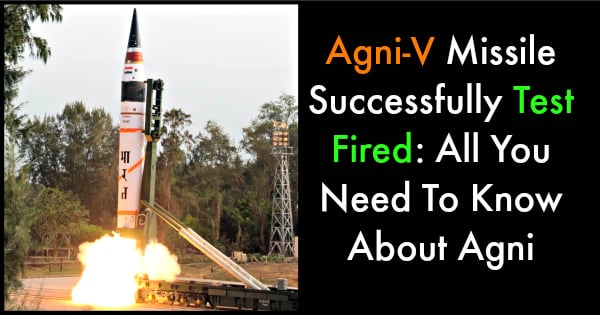India test fired the intercontinental ballistic missile (ICBM) Agni-V about a week ago, around the same time when Israeli PM Benjamin Netanyahu visited India. The Agni V is developed by the DRDO and was test fired with the help of Strategic Forces Command. It is a part of the Agni series of missiles, one of the missile systems under the IGMDP (Integrated Guided Missile Development Program).
With this pre-induction trial, India is a step away from entering the club of countries having ICBMs in their armoury which already has US, UK, Russia, China and France. North Korea’s ICBMs are uncertain on whether they are operational or not.
About the Test:
The missile was test fired from the Abdul Kalam Island, near the Odisha coast. This was the 5th time that India tested Agni V since 2012. The timeline of Agni V test fire is as follows:
First Test: 19 April 2012
Second Test: 15 September 2013
Third Test: 31 January 2015
Fourth Test: 26 December 2016
The missile was launched from a canister atop the road-mobile launcher to a height of over 600-km in its parabolic trajectory. It came down around 4,900-km away towards Australia in the Indian Ocean after about 19 minutes later.
With help of the canister-launch capability, India can swiftly transport and fire the missile from anywhere it wants. The missile is already loaded with its nuclear warhead before being sealed in the canister, it drastically cuts down the response or reaction time for a retaliatory strike. It just needs the authorised electronic codes to unlock it for launch.
The missile’s flight performance during the test was monitored by radars, range stations and tracking systems all through the mission. All mission objectives were successfully met.
About Agni V:
It is the most advanced missile in the Agni series with new technologies incorporated in it in terms of navigation and guidance, warhead and engine.
It is a 17-metre-long Intercontinental Ballistic Missile. It can carry a payload of 1.5 tonnes and can transport a fusion-boosted fission weapon nuclear device.
Agni 5 is a fire and forget missile. That means, after it has been fired once, it cannot be stopped except by an interceptor missile. Only the US, Russia and Israel have an interceptor missile as of now.
The range of Agni V missile is 5,500–5,800 km. However, Chinese sources said that the missile has a range of around 8,000 km.
The missile covers parts of Europe and Africa in range. Another pre-induction trial is expected in 2018 itself before it is inducted.
The current range of Agni is still lower than the Chinese missiles having ranges like 11,200 km and 14,500km.
It consists of a high-speed onboard computer, fault-tolerant software and robust & reliable bus to guide the missile. The navigation systems include very high accuracy Ring Laser Gyro-based Inertial Navigation System (RINS) and a Micro Navigation System (MINS).
India developed Agni V in 10 years, while most other countries took over 15 years. More than 300 scientists and engineers from DRDO have been involved in making the missile.
China’s Reaction:
India has close military ties with Australia, Japan and the US which poses a direct threat to China.
China believes that this test constitutes a direct threat to China’s security and that the testing of the nuclear-capable ICBM is a challenge to global nuclear-non proliferation efforts.
A Chinese missile expert even said that though the missile could theoretically hit Beijing, India’s missile technique is far below the standard.
As a solution, Chinese missile expert suggests increasing the economic and military presence in the Indian Ocean region. It also suggests Chinese authorities be alert and focus on upgrading their anti-missile techniques.
China is estimated to possess 75-100 ICBMs and 50-75 launchers.
Conclusion:
This successful test of Agni-V reaffirms the country’s indigenous missile capabilities and further strengthens our credible deterrence.
India already possesses long-range nuclear missiles like Prithvi, Agni I, II and II and supersonic cruise missiles like Brahmos while subsonic cruise missiles like Nirbhay are still under development.
India is already working on the development of Agni-VI and enhancing the range of Agni-V. On being commissioned, Agni V will have entire Asia and most parts of Europe within its range.





